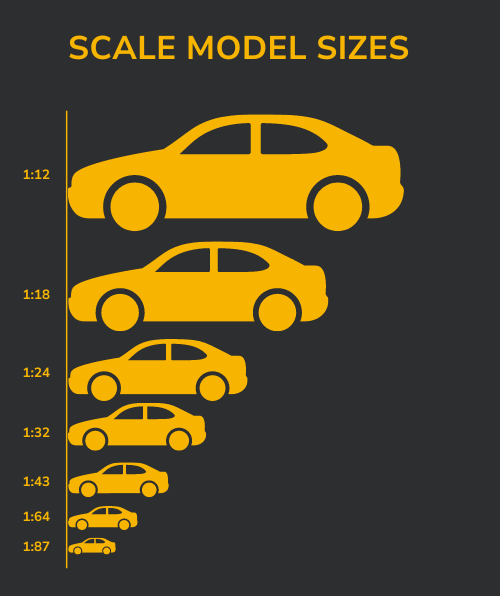Understanding Model Car Scales: A Comprehensive Guide for Collectors and Enthusiasts
Model car collecting is a rewarding hobby that combines artistry, craftsmanship, and nostalgia. One crucial aspect of this hobby is understanding the different scales used for model cars. Knowing these scales and their dimensions can significantly enhance your collecting experience. In this guide, we’ll explore various model car scales, their dimensions in both imperial and metric systems, and offer tips on choosing the right scale for your collection.
What is Model Car Scale?
Model car scale refers to the ratio of the model’s size compared to the actual vehicle. For example, a 1:18 scale model is 1/18th the size of the real car. Understanding these scales helps collectors organize their models and create a consistent and visually appealing display.
Popular Model Car Scales
- 1:87 Scale
- Dimensions: Approximately 1.5 to 2 inches (3.8 to 5.1 cm) long.
- Overview: Also known as HO scale, 1:87 is commonly used for model trains and vehicles. It’s one of the smallest scales for die-cast models, offering a compact size with reasonable detail.
- Advantages: Ideal for creating large, detailed dioramas or collections in limited space.
- Use Case: Perfect for collectors who want to include a large number of models in a small display area.
- 1:72 Scale
- Dimensions: Approximately 2 to 3 inches (5.1 to 7.6 cm) long.
- Overview: This scale is often used for model aircraft but is also applicable to vehicles. It offers slightly larger models than 1:87, with good detail for its size.
- Advantages: Provides a balance between size and detail, suitable for smaller displays.
- Use Case: Suitable for collectors who appreciate compact models with a bit more detail than 1:87.
- 1:64 Scale
- Dimensions: Approximately 3 to 4 inches (7.6 to 10.2 cm) long.
- Overview: Known for its use in "Hot Wheels" and "Matchbox" cars, 1:64 scale is very popular among collectors. These models are small, affordable, and widely available.
- Advantages: Compact size allows for extensive collections and is easy to display.
- Use Case: Ideal for those who want to build a large collection or have limited display space.
- 1:43 Scale
- Dimensions: Approximately 4 to 5 inches (10.2 to 12.7 cm) long.
- Overview: Commonly used for high-quality die-cast models, this scale offers a good balance between size and detail.
- Advantages: Provides a reasonable amount of detail and is still manageable in size.
- Use Case: Suitable for collectors who want detailed models without needing too much space.
- 1:32 Scale
- Dimensions: Approximately 4 to 5 inches (10.2 to 12.7 cm) long.
- Overview: This scale is often used for slot cars and larger die-cast models. It provides a good level of detail while remaining manageable in size.
- Advantages: Offers more detail and realism compared to smaller scales while still being relatively easy to display.
- Use Case: Ideal for collectors who appreciate detailed models but have moderate space constraints.
- 1:24 Scale
- Dimensions: Approximately 5 to 6 inches (12.7 to 15.2 cm) long.
- Overview: A popular scale for both die-cast and plastic models, 1:24 offers a balance between size and detail.
- Advantages: Provides a detailed representation of the original vehicle while being easy to handle.
- Use Case: Suitable for collectors who want detailed models but need to keep their collection manageable.
- 1:18 Scale
- Dimensions: Approximately 6 to 8 inches (15.2 to 20.3 cm) long.
- Overview: These larger models offer extensive detail and often feature functional parts such as opening doors and hoods.
- Advantages: High levels of detail and functionality; great for showcasing intricate designs.
- Use Case: Ideal for serious collectors with ample display space who want highly detailed models.
- 1:12 Scale
- Dimensions: Approximately 8 to 12 inches (20.3 to 30.5 cm) long.
- Overview: Less common but known for its exceptional detail and accuracy. This scale often includes functional parts and is used for high-end collector models.
- Advantages: Offers impressive realism and craftsmanship with highly accurate representations of the original vehicles.
- Use Case: Best for collectors who have plenty of space and want their models to be the focal point of their collection.
Here is a better visualization of the model scale sizes.

Choosing the Right Scale
Selecting the right scale for your collection depends on several factors:
- Display Space: Smaller scales like 1:87 or 1:72 are better for limited spaces, while larger scales such as 1:18 or 1:12 require more room.
- Budget: Larger and more detailed models tend to be more expensive. Assess your budget and choose scales that fit within it.
- Detail and Functionality: Larger scales offer more detail and functional features. Smaller scales are more affordable and easier to store.
- Existing Collection: Match new models with your current collection scale for a cohesive display.
Conclusion
Understanding model car scales is essential for both new and seasoned collectors. Each scale offers unique advantages and challenges, and selecting the right one can greatly influence your collecting experience. Whether you prefer the compact convenience of 1:87 models or the detailed craftsmanship of 1:12 models, knowing the scales and their dimensions helps you build a collection that suits your personal preferences and display needs. Happy collecting!
Feel free to share your experiences or ask questions about model car scales in the comments below!
Get our Diecast Parking App which is your virtual parking for model cars.
You can get it on iOS store and Google Play store. It free to use up to 50 models. Join our fast growing community!